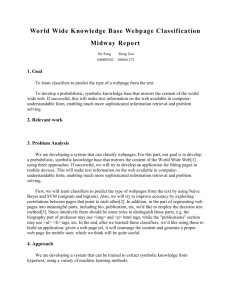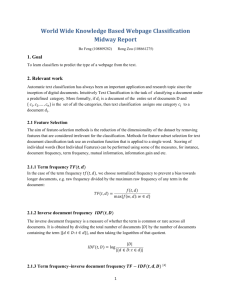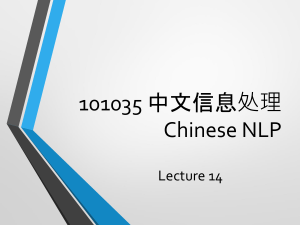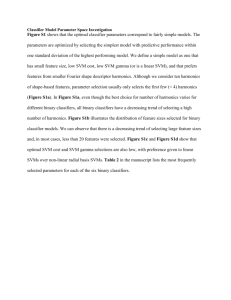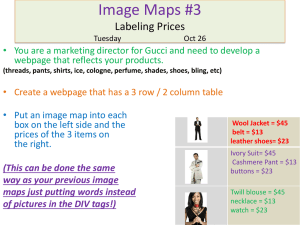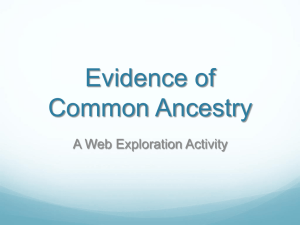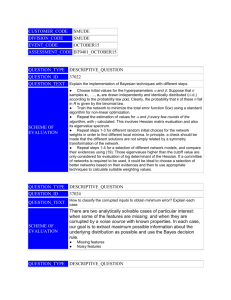Midway Report4
advertisement
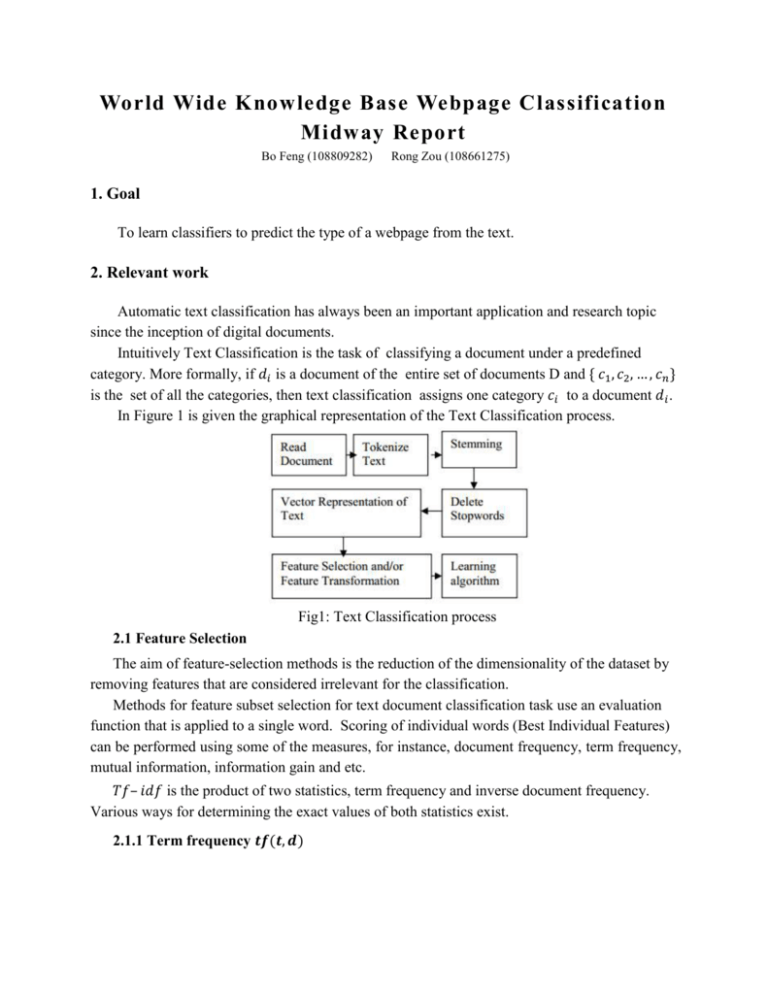
World Wide Knowledge Base Webpage Classification
Midway Report
Bo Feng (108809282)
Rong Zou (108661275)
1. Goal
To learn classifiers to predict the type of a webpage from the text.
2. Relevant work
Automatic text classification has always been an important application and research topic
since the inception of digital documents.
Intuitively Text Classification is the task of classifying a document under a predefined
category. More formally, if 𝑑𝑖 is a document of the entire set of documents D and { 𝑐1 , 𝑐2 , … , 𝑐𝑛 }
is the set of all the categories, then text classification assigns one category 𝑐𝑖 to a document 𝑑𝑖 .
In Figure 1 is given the graphical representation of the Text Classification process.
Fig1: Text Classification process
2.1 Feature Selection
The aim of feature-selection methods is the reduction of the dimensionality of the dataset by
removing features that are considered irrelevant for the classification.
Methods for feature subset selection for text document classification task use an evaluation
function that is applied to a single word. Scoring of individual words (Best Individual Features)
can be performed using some of the measures, for instance, document frequency, term frequency,
mutual information, information gain and etc.
𝑇𝑓– 𝑖𝑑𝑓 is the product of two statistics, term frequency and inverse document frequency.
Various ways for determining the exact values of both statistics exist.
2.1.1 Term frequency 𝒕𝒇(𝒕, 𝒅)
In the case of the term frequency tf(t, d), we choose normalized frequency to prevent a bias
towards longer documents, e.g. raw frequency divided by the maximum raw frequency of any
term in the document:
𝑓(𝑡, 𝑑)
𝑡𝑓(𝑡, 𝑑) =
max{𝑓(𝑤, 𝑑): 𝑤 ∈ 𝑑}
2.1.2 Inverse document frequency 𝒊𝒅𝒇(𝒕, 𝑫)
The inverse document frequency is a measure of whether the term is common or rare across
all documents. It is obtained by dividing the total number of documents by the number of
documents containing the term, and then taking the logarithm of that quotient.
log|𝐷|
𝑖𝑑𝑓(𝑡, 𝐷) =
|{𝑑 ∈ 𝐷: 𝑡 ∈ 𝑑}|
|𝐷|: the total number of documents in the corpus
|{𝑑 ∈ 𝐷: 𝑡 ∈ 𝑑}|: number of documents where the term 𝑡 appears (i.e., 𝑡𝑓(𝑡, 𝑑) ≠ 0).
If the term is not in the corpus, this will lead to a division-by-zero. It is therefore
common to adjust the formula to 1 + |{𝑑 ∈ 𝐷: 𝑡 ∈ 𝑑}| .
Mathematically the base of the log function does not matter and constitutes a constant
multiplicative factor towards the overall result.
2.1.3 Term frequency–inverse document frequency 𝒕𝒇 − 𝒊𝒅𝒇(𝒕, 𝒅, 𝑫) [4]
Then 𝑡𝑓– 𝑖𝑑𝑓 is calculated as
𝑡𝑓𝑖𝑑𝑓(𝑡, 𝑑, 𝐷) = 𝑡𝑓(𝑡, 𝑑) × 𝑖𝑑𝑓(𝑡, 𝐷)
A high weight in 𝑡𝑓– 𝑖𝑑𝑓 is reached by a high term frequency (in the given document) and a
low document frequency of the term in the whole collection of documents; the weights hence
tend to filter out common terms. Since the ratio inside the idf's log function is always greater
than or equal to 1, the value of idf (and tf-idf) is greater than or equal to 0. As a term appears in
more documents, the ratio inside the logarithm approaches 1, bringing the idf and tf-idf closer to
0.
2.2 Machine Learning Algorithms
After feature selection and transformation the documents can be easily represented in a
form that can be used by a ML algorithm. Many text classifiers have been proposed in the
literature using machine learning techniques, probabilistic models, etc. They often differ in the
approach adopted: Decision Trees, Naïve-Bayes, Rule Induction, Neural Networks, Nearest
Neighbors, and lately, Support Vector Machines.
Naive Bayes is often used in text classification applications and experiments because of its
simplicity and effectiveness [6]. However, its performance is often degraded because it does not
model text well.
Support vector machines (SVM), when applied to text classification provide excellent
precision, but poor recall. One means of customizing SVMs to improve recall, is to adjust the
threshold associated with an SVM. Shanahan and Roma described an automatic process for
adjusting the thresholds of generic SVM [7] with better results.
Johnson et al. described a fast decision tree construction algorithm that takes advantage of
the sparsity of text data, and a rule simplification method that converts the decision tree into a
logically equivalent rule set [8].
3. Problem Analysis
We are developing a system that can classify webpages. For this part, our goal is to develop
a probabilistic, symbolic knowledge base that mirrors the content of the World Wide Web[1]
using three approaches. If successful, we will try to develop an application for fitting pages in
mobile devices. This will make text information on the web available in computerunderstandable form, enabling much more sophisticated information retrieval and problem
solving.
First, we will learn classifiers to predict the type of webpages from the text by using Naïve
Bayes and SVM (unigram and bigram). Also, we will try to improve accuracy by exploiting
correlations between pages that point to each other[2].
In addition, in the part of segmenting web pages into meaningful parts, including bio,
publication, etc, we'd like to employ the decision tree method[3]. Since intuitively there should be
some rules to distinguish those parts, e.g. the biography part of professor may use <img> and <p>
html tags, while the "publications" section may use <ul> <li> tags, etc. In the end, after we
learned those classifiers, we’d like using these to build an application: given a web page url, it
will rearrange the content and generate a proper web page for mobile user, which we think will
be quite useful.
4. Approach
4.1 Feature Selection
We extract text features using 𝑇𝐹 and 𝑇𝐹 − 𝐼𝐷𝐹 (term frequency–inverse document
frequency), which reflects how important a word is to a document in a collection or corpus.
4.2 Algorithm
We are developing a system that can be trained to extract symbolic knowledge from
hypertext, using a variety of machine learning methods:
1) Naïve Bayes
2) SVM
3) Bayes Network
4) HMM
In additon, we try to improve accuracy by (1) exploiting correlations between pages that
point to each other, and (2) segmenting the pages into meaningful parts (bio, publications, etc.)
6. Dataset
6.1 Dataset
A dataset from 4 universities containing 8,282 web pages and hyperlink data, labeled with
whether they are professor, student, project, or other pages.
For each class the data set contains pages from the four universities:
Cornell (867)
Texas (827)
Washington (1205)
Wisconsin (1263)
and 4,120 miscellaneous pages collected from other universities.
6.2 Test & Train Data Splits
Since each university's web pages have their own idiosyncrasies, we train on three of the
universities plus the miscellaneous collection, and testing on the pages from a fourth, held-out
university, which is 4-fold cross validation.
6.3 Vector Space Webpage Representations
A webpage is a sequence of words. So each webpage is usually represented by an array of
words. The set of all the words of a training set is called vocabulary, or feature set. So a webpage
can be presented by a binary vector, assigning the value 1 if the webpage contains the featureword or 0 if the word does not appear in the webpage. This can be translated as positioning a
webpage in a 𝑅 |𝑉| space, where |𝑉| denotes the size of the vocabulary.
7. Results
Expected Milestone Result: Learn classifier using at least two of these methods in a subset
dataset:1) develop a system that can be trained to extract symbolic knowledge from
hypertext using Naïve Bayes and SVM; 2) exploit correlations between pages that point to
each other; 3) Segment the pages into meaningful parts using decision tree.
Actual Milestone Result:
We learned 2 classifiers:
1) Naïve Bayes classifier
We use 𝑃(𝑤𝑜𝑟𝑑|𝑐𝑙𝑎𝑠𝑠) to train classifier, which achieves accuracy at 16%.
2) SVM classifier using TF-IDF(unigram)
We achieved 70% predict precision by using SVM classifier, where we select
features using unigram based on TF-IDF.
After that, we focused on the correlation between pages that point to each other.
8. Reference
[1] Learning to Construct Knowledge Bases from the World Wide Web. M. Craven, D. DiPasquo, D. Freitag,
A. McCallum, T. Mitchell, K. Nigam and S. Slattery. Artificial Intelligence.
[2] Learning to Extract Symbolic Knowledge from the World Wide Web. M. Craven, D. DiPasquo, D. Freitag,
A. McCallum, T. Mitchell, K. Nigam and S. Slattery. Proceedings of the 15th National Conference on
Artificial Intelligence (AAAI-98).
[3] Data Mining on Symbolic Knowledge Extracted from the Web. Rayid Ghani, Rosie Jones, Dunja
Mladenic, Kamal Nigam and Sean Slattery. KDD-2000 Workshop on Text Mining. 2000
[4] tf–idf, http://en.wikipedia.org/wiki/Tfidf
[5] Zu G., Ohyama W., Wakabayashi T., Kimura F., "Accuracy improvement of automatic text classification
based on feature transformation": Proc: the 2003 ACM Symposium on Document Engineering, November 20 22, 2003, pp.118-120
[6] Kim S. B., Rim H. C., Yook D. S. and Lim H. S., “Effective Methods for Improving Naive Bayes Text
Classifiers”, LNAI 2417, 2002, pp. 414-423
[7] Shanahan J. and Roma N., Improving SVM Text Classification Performance through Threshold
Adjustment, LNAI 2837, 2003, 361-372
[8] D. E. Johnson, F. J. Oles, T. Zhang, T. Goetz, “A decision-tree-based symbolic rule induction system for
text categorization”, IBM Systems Journal, September 2002.
